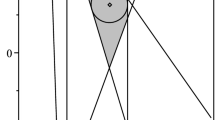Abstract
Sections 1 and 2 discuss the advantages of an object-oriented implementation combined with higher floating-point arithmetic, of the algorithms available for multivariate data fitting using rational functions. Section 1 will in particular explain what we mean by “higher arithmetic”. Section 2 will concentrate on the concepts of “object orientation”. In sections 3 and 4 we shall describe the generality of the data structure that can be dealt with: due to some new results virtually every data set is acceptable right now, with possible coalescence of coordinates or points. In order to solve the multivariate rational interpolation problem the data sets are fed to different algorithms depending on the structure of the interpolation points in then-variate space.
This text is a preparatory publication for the development of a scientific expert system for multivariate rational interpolation. The issues addressed are relevant to the implementation of such a system.
Similar content being viewed by others
References
J. Abouir and A. Cuyt, Multivariate partial Newton-Padé and Newton-Padé type approximants, J. Approx. Th. (to appear).
Acrith-XSC: IBM High Accuracy Arithmetic — Extended Scientific Computation. Version 1, Release 1, IBM Deutschland GmbH, Department 3282, Böblingen.
ARITHMOS (BS2000): Benutzerhandbuch, SIEMENS AG, Bereich Datentechnik.
H. Arndt, Ein verallgemeinter Kettenbruch-Algorithmus zur rationalen Hermite-Interpolation. Numer. Math. 36 (1980) 99–107.
C. Brezinski, A general extrapolation algorithm, Numer. Math. 35 (1980) 175–187.
A. Cuyt, A recursive computation scheme for multivariate rational interpolants, SIAM J. Num. Anal. 24 (1987) 228–238.
A. Cuyt, Extension of “A multivariate convergence theorem of the de Montessus de Ballore type” to multipoles, J. Comp. Appl. Math. 41 (1992) 323–330.
A. Cuyt, Multivariate rational interpolation: old and new results, in preparation.
A. Cuyt and B. Verdonk, General order Newton-Padé approximants for multivariate functions, Numer. Math. 43 (1984) 293–307.
A. Cuyt and B. Verdonk, Different techniques for the construction of multivariate rational interpolants, in:Nonlinear Numerical Methods and Rational Approximation, ed. A. Cuyt (1988) pp. 167–190.
A. Cuyt and B. Verdonk, Evaluation of branched continued fractions using block-tridiagonal linear systems, IMA J. Numer. Anal. 8 (1988) 209–217.
C. Falcó Korn, S. Gutzwiller, S. König and Ch. Ullrich, Modula-SC. Motivation, language definition and implementation, IMACS Ann. Comput. Appl. Math. 12 (1992) 161–179.
FORTRAN for scientific computation. Language description and sample programs, Institute for Applied Mathematics, University of Karlsruhe.
D. Goldberg, What every computer scientist should know about floating-point arithmetic, ACM Comp. Surv. 23 (1991) 5–48.
P. Graves-Morris, Practical, reliable, rational interpolation, J. Inst. Math. Appl. 25 (1980) 267–286.
W. Krämer, Highly accurate evaluation of program parts with applications, IMACS Ann. Comput. Appl. Math. 7 (1990) 397–409.
U. Kulisch (ed.),Pascal-SC: Information Manual and Floppy Disks (Wiley-Teubner, Stuttgart, 1987).
U. Kulisch and W. Miranker,Computer Arithmetic in Theory and Practice (Academic Press, New York, 1981).
U. Kulisch and W. Miranker, The arithmetic of the digital computer: a new approach, SIAM Rev. 28 (1986) 1–36.
C. Lawo, C-XSC, A programming environment for eXtended Scientific Computation,Proc. 13th IMACS World Congress, vol. 1 (1991) p. 34.
J. Miklosko, Investigation of algorithms for numerical computation of continued fractions, USSR Comp. Math. Math. Phys. 16 (1976) 1–12.
Ch. Ullrich and J. Wolff von Gudenberg (eds.),Accurate Numerical Algorithms: A Collection of Research Papers (Springer, Berlin, 1989).
J. Wolff von Gudenberg, Object-oriented concepts for scientific computation, IMACS Ann. Comput. Appl. Math. 12 (1992) 181–192.
R. Klatte, V. Kulisch, M. Neaga, D. Ratz and C. Ullrich (eds.),Pascal-XSC. Language Reference with Examples (Springer, Berlin, 1992).
Author information
Authors and Affiliations
Rights and permissions
About this article
Cite this article
Cuyt, A., Verdonk, B. Multivariate rational data fitting: general data structure, maximal accuracy and object orientation. Numer Algor 3, 159–172 (1992). https://doi.org/10.1007/BF02141925
Issue Date:
DOI: https://doi.org/10.1007/BF02141925




